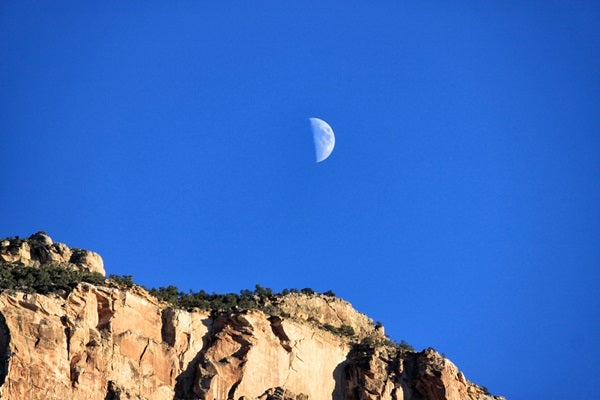In fact, the Moon is quite noticeable at various times on most days throughout its monthly cycle (except for about two to three days before or after New Moon).
Scanners
Once the Sun rises, humans seem to be naturally programmed to look (literally) down and out, but not necessarily up. This is mainly a protective mechanism due to the immense brilliance of the solar disk. But up is where you’d have to direct your gaze most of the time to see the daytime Moon.
I tried being a daytime skywatcher for a couple of weeks, noting where my vision takes me naturally throughout the day. What I discovered was, in a sense, biblical: “Let your eyes look straight ahead; fix your gaze directly before you” (Proverbs 4:25). My gaze remained relatively focused forward with occasional sweeps from side to side.
Research has shown that if we have such a horizontal line of sight, we see (on average) more Earth than sky: roughly 35° below the horizontal (Earth), and about 25° above the horizontal (the sky). My own observations support these figures. We can extend our sky coverage to approximately 50° by simply rolling our eyes up while keeping a level head, but that probably requires a reason to do so, such as when a bird flitters by.
Hide-and-seek Moon
The previous figures suggest that as we go about our day, we do not see the Moon unless it happens to be within 25° of the horizon and we happen to be looking in that direction. This usually occurs in the middle to late afternoon after First Quarter and before Full Moon, or in the early to late morning after Full Moon and before Last Quarter.
Around these times, the Moon is also at or near its brightest (between magnitudes –10 and –13), so you’re more likely to notice it. Add possible horizon obstructions such as trees and buildings, and the fact that many of us are working or equally occupied for large chunks of the day.
See the light
During the night, there is not much of interest on the ground, which under natural conditions is swathed in darkness. So we look up where all manner of celestial lights caress our eyes.
We notice the Moon, mainly because it is the brightest object in the night sky. During the day, however, the Moon hands over its crown to the Sun and then gracefully slips into the background.
If you happen to notice the Moon in a blue sky while you’re with other people, ask them if they’ve noticed it today. Then listen to their replies, and perhaps learn something new about human perception. As always, send your thoughts to sjomeara31@gmail.com.












